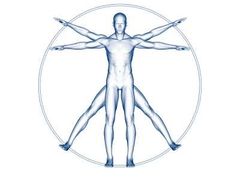![]()
![]()
![]()
Use LEFT and RIGHT arrow keys to navigate between flashcards;
Use UP and DOWN arrow keys to flip the card;
H to show hint;
A reads text to speech;
36 Cards in this Set
- Front
- Back
- 3rd side (hint)
|
Anatomy |

The study of the structure and relationships between body parts. The study of structures of living things, so it's the branch of science that describes what body parts like your fingers, mouth, nose, heart, and lungs look like. |
The structure of parts |
|
|
Physiology |

The science of how those parts come 2gether to function and keep that body alive. |
How parts funtion. |
|
|
Polymorphous |
Occurring in several different forms or stages. |
|
|
|
Anatomy Act (1832) |
Provided students plenty of dead human corpses in the form of executed murderers. |
|
|
|
Educational Cadavers |
People who donate their bodies to science when they die. |
|
|
|
Atoms |
Our bodies have about 7 Octillion . |
|
|
|
Smallest Cell in Your Body |
Red Blood Cell |
|
|
|
Levels of Body Organization |
1. Atoms 2. Cells 3. Tissues 4. Organs 5. Organ Systems 6. The Body |
|
|
|
Homeostasis |
The abilitily to maintain stable, internal conditions no matter what changes are occurring outside the body. |
|
|
|
Motor Neuron |
largest cell in the body |
|
|
|
Organs |
W |
|
|
|
Tissues |
M |
|
|
|
Organ Systems |
Cns |
|
|
|
Death |
The extreme and irreversible loss of homeostasis. |
|
|
|
Anatomical Position |

Where the body is erect and facing forward with arms at the side and palms forward. |
|
|
|
Directional Terms (Verbal Map) |
Hyper-precise language that identifies parts of the body and communicate whats happening to them. |
|
|
|
Sagittal Plane (median plane) |
Divides the body vertically down the middle into left and right parts. |
|
|
|
Parasagittal plane |

A parasagittal plane is any plane that divides the body into left and right portions, parallel to the sagittal plane, but not directly in the midline. Thus a parasagittal plane divides the body into unequal left and right portions, but remains parallel to the median or sagittal suture. |
|
|
|
Coronal Plane (frontal plane) |
Splits the body vertically into front and back. |
|
|
|
Transverse Plane (horizontal plane) |
Splits everything divides the body top & body. |
|
|
|
Axial Parts |
Everything (parts) in line with the center of the body. |
Head, neck, & trunk (body). |
|
|
Appendicular Parts |
Appendiges that connect to the bodies axis. |
Arms & Legs |
|
|
Anterior (ventral) |
Front part of the body. |
Eyes |
|
|
Posterior (dorsal) |
Back of the body. |
Butt lol |
|
|
Superior (cranial) |
Towards the top of the body. |
Head |
|
|
Inferior Caudial |
Towards the bottom. |
|
|
|
Medial |
Structures toward the midline. |
|
|
|
Lateral |
Structures further away 4m da midline. |
|
|
|
Proximal |
The part of your appendiges that ar closer to the midline. |
|
|
|
Distal |
Part of your appendiges that are farther away from the trunk or center of the body. |
|
|
|
Neurotransmitters |

Neurotransmitters are often referred to as the body’s chemical messengers. They are the molecules used by the nervous system to transmit messages between neurons, or from neurons to muscles.Communication between two neurons happens in the synaptic cleft (the small gap between the synapses of neurons). Here, electrical signals that have travelled along the axon are briefly converted into chemical ones through the release of neurotransmitters, causing a specific response in the receiving neuron.A neurotransmitter influences a neuron in one of three ways: excitatory, inhibitory or modulatory. |
|
|
|
Glial Cells |
Glia, also called glial cells or neuroglia, are non-neuronal cells in the central nervous system (brain and spinal cord) and the peripheral nervous system. They maintain homeostasis, form myelin, and provide support and protection for neurons. |
White Matter |
|
|
Corpus Collosum |
corpus callosum (in green). a large fiber bundle that connects the left and right hemispheres, facilitating communication between them |
|
|
|
Synaptic Terminals |
. |
|
|
|
Wat are da major types of neurotransmitters? |
1.Serotonin 2.Dopamine 3.GABA 4.Norepinephrine |
|
|
|
Hormones |
Hormones are special chemical messengers in the body that are created in the endocrine glands. These messengers control most major bodily functions, from simple basic needs like hunger to complex systems like reproduction, and even the emotions and mood. |
|

